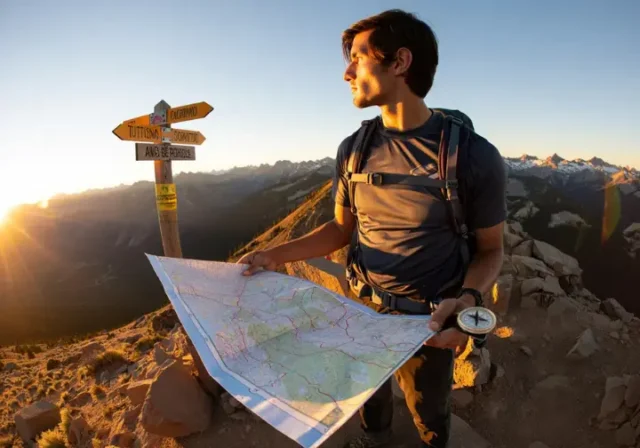In this article
The sheer number of hiking trip options in the state of Colorado can feel overwhelming, from guided ascents of towering peaks to quiet, self-reliant backpacking trips into the wilderness. Choosing the right trip is more than just picking a hiking trail; it’s a rewarding planning process that requires understanding your personal needs, constraints, and the unique challenges of Colorado’s environment. This guide moves you from an abstract desire for a trip to a concrete set of actionable options. We provide a strategic framework to build your ideal hiker profile, compare commercial outfitters, and empower you with the knowledge to plan your own epic Colorado adventure.
Architecting Your Ideal Hiking Experience
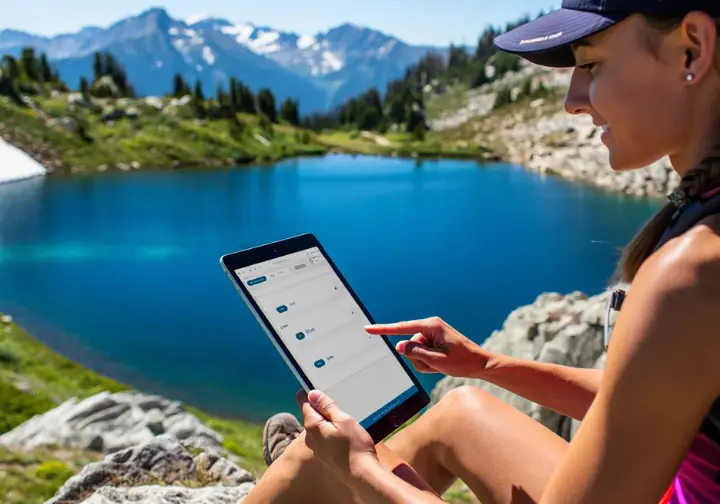
To architect your ideal hiking experience, you first need a foundational mental model to define your trip parameters and adventure requirements before looking at specific trails or tours. We’ll transform a simple checklist into a strategic planning funnel, ensuring the recommendations that follow are relevant and actionable.
Defining Your Time Commitment and Pace
A trip’s feasibility begins with a realistic “time budget,” which must include not just hiking time but also travel to and from the trail head. A four-hour hike with a two-hour drive each way is a full-day commitment, a detail that can derail a schedule if overlooked. This calculation is the first and most critical filter in the planning process.
Mileage is a deceptive metric in the mountains. Steep grades and high altitude drastically reduce pace, and a sea-level walking speed of three miles per hour can easily drop to one or two in the Colorado backcountry. Truly understanding your pace is crucial for setting achievable goals and avoiding overexertion, especially for unacclimatized visitors.
As a practical rule of thumb, a typical two-hour round-trip hike in the mountains will likely cover a distance of 2-5 miles. A mile round-trip hike of this nature provides a tangible starting point for beginners or those unfamiliar with mountain terrain to select an appropriate trail without overestimating their capacity. Using this guideline helps prevent common planning errors and ensures a more enjoyable experience.
Identifying Scenery and Desired Outcome
The “why” of a hike is often the scenery, which serves as the primary motivation. Colorado offers a vast menu of visual rewards, from panoramic summit views that create stunning mountain vistas and historic mining ruins that speak to the area’s mountain history to vibrant Colorado wildflowers like the Colorado Columbine in alpine meadows, cascading waterfalls, or serene alpine lakes. Clearly identifying this scenic goal is the first step in narrowing down potential destinations and finding truly iconic bucket list hiking trails.
It’s critical to avoid “destination fever”—an intense focus on reaching a specific point that leads to underestimating the journey’s difficulty. Planners must balance the allure of the destination with a realistic assessment of the trail’s length, elevation gain, and conditions. This ensures the entire experience, not just the endpoint, is safe and enjoyable.
The desired outcome can also extend beyond scenery to include specific experiences like solitude, a physical challenge, or wildlife photography. A hiker seeking tranquility should avoid highly trafficked “classic” trails on a weekend, while someone aiming to conquer a 14er has a very different set of trail requirements. Defining this experiential goal helps filter trail options more effectively.
Assessing Group Dynamics and Skill Level
The composition and fitness of your group are paramount, as a group is only as fast and strong as its least experienced member. A trip plan must be built around an honest assessment of everyone’s abilities, whether the group includes seasoned mountaineers, a family with young children, or friends visiting from sea level who are new to hiking. Mismatched expectations are a common source of conflict and safety issues on the trail.
This assessment directly informs the choice of trail, ensuring it is appropriate for every participant. Following essential tips for beginner hikers is a good start. An easy, low-elevation trail near a town like Breckenridge might be perfect for a family, while a technical route is better for experienced peers. This prevents putting any group member in a situation beyond their comfort level.
The planning stage is the ideal time to establish the role of a “trip leader” or hiking leader who is responsible for the group’s overall well-being. This leader’s duty is to ensure the chosen hike is safe, appropriate, and enjoyable for everyone, not just the most ambitious person in the group. This proactive leadership is a key component of a successful and safe group hike.
Understanding Seasonality and Trail Conditions
Seasonality is the dominant factor in Colorado hiking. A common mistake is assuming “summer” is a monolithic season; in the high country, trails can hold a deep alpine snowpack and remain snow-covered well into June or even early July, requiring specialized gear for winter hiking like microspikes. Early summer is often defined by mud, snow, and swollen creeks, which calls for careful trail selection.
A significant hazard of Colorado summers, especially in July and August, is the daily risk of afternoon thunderstorms. These storms develop rapidly, bringing intense lightning, which is particularly dangerous above the treeline on the exposed alpine tundra. This reality necessitates an early start for any high-altitude hike to be safely below exposed areas by noon.
Responsible hiking, a core tenet of Leave No Trace ethics, means actively avoiding muddy trails. Hiking on saturated ground causes significant, long-term erosion and damages the trail ecosystem. When trails are wet and muddy, especially in the early season, choosing lower-elevation, drier trails is the more sustainable and safer option.
Analyzing Physicality: Difficulty and Elevation Gain
To truly gauge a trail’s difficulty, a hiker must look beyond mileage and consider the elevation profile. While some systems use subjective ratings like Green, Blue, or Black, these often incorporate technical factors like trail narrowness or exposure. The most reliable and objective metric for physical demand is the total elevation gain.
The trail’s elevation profile, available on apps like AllTrails or CalTopo, provides a visual map of the entire hike’s ascents and descents. This is far more informative than the net elevation change. Analyzing this profile allows a hiker to see if a climb has a gradual slope or is a short and brutally steep incline.
Empowering yourself to find and interpret this data is a key step toward self-sufficiency. By learning to read an elevation profile, a hiker can accurately match their physical fitness to the demands of the climbs on a specific trail. This skill is fundamental to making informed decisions and is a prerequisite for anyone considering transitioning from day hiking to backpacking.
The Commercial Landscape of Guided Hiking Services
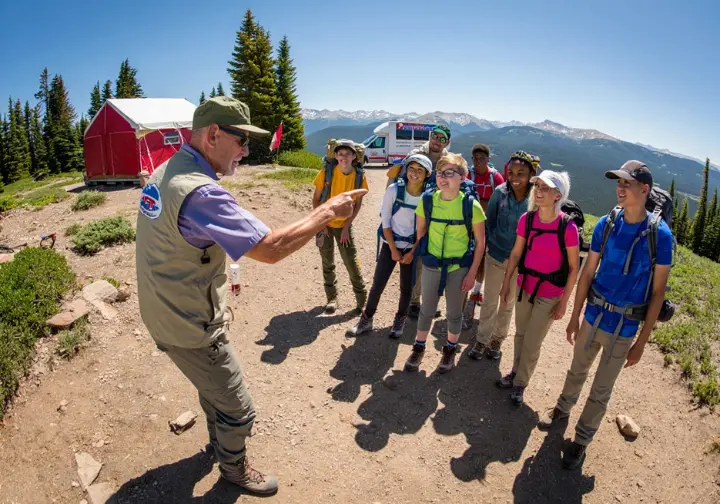
To address the search for commercial options, we’ll start with an analytical overview of the guided hiking trips market in Colorado. This look at guided hiking tours and top Colorado destinations will answer your initial query before we pivot to more educational, DIY-focused content.
Understanding Guided Trip Formats: From Backpacking to Inn-Based Tours
All-Inclusive Backpacking Trips (or backpacking tours) represent the quintessential guided wildland backcountry experience. A guide company handles all group gear, meals, and permits for a multi-day camping trip. Clients typically carry a pack of 25-45 pounds with personal items and shared gear. This format, offered by companies like Wildland Trekking, is ideal for those wanting a remote wilderness experience with expert support.
Basecamp Tours offer a blend of adventure and comfort, using a fixed, vehicle-accessible campground as a hub for daily hikes. Participants carry only light daypacks for excursions and return to a well-equipped camp with prepared meals each evening. This model eliminates the daily setup and breakdown of camp, maximizing time for hiking and relaxation. Depending on the company, you can find guided tours, independent travel, or self-guided packages to suit your preference.
Inn-Based Tours (often called inn-based hiking tours) are the most comfortable option, combining guided day hikes with nightly stays in hotels or lodges. This format is perfect for those who love the trail but prefer modern amenities. Outfitters like Wildland Trekking and the YMCA of the Rockies offer numerous themed and seasonal inn-based trips.
Niche Excursions like Llama Treks and multi-day Snowshoe Tours provide unique ways to experience the Colorado wilderness. Llama treks use pack animals to carry gear, allowing for more comfortable backcountry trips, while guided snowshoeing opens up the state’s winter landscape with expert guidance.
The “Slack-Packing” Model: A Bridge to Adventure
“Slack-packing” is an innovative hybrid model, particularly well-suited for long-distance routes like The Colorado Trail. In this supported trek format, hikers carry only a light daypack with essentials, while a support vehicle transports their heavy overnight gear, food, and camping equipment to the next camp. Outfitters like Colorado Mountain Expeditions often handle this service. You can learn more about various guided and supported trips directly from the experts.
This model offers the experience of a multi-day, point-to-point hike without the physical burden of a heavy backpack. It effectively separates hiking from carrying, making ambitious, high-mileage objectives more accessible to a wider range of hikers and aspiring through-hikers. It’s an excellent option for those with limited time or physical constraints. For those inspired by long-distance treks, there are many great narratives that explore thru-hiking and its challenges.
Slack-packing serves as a perfect “bridge” for hikers looking to transition towards more self-sufficient adventures. It addresses the need for logistical support while providing a more authentic and skill-building experience than a fully catered tour. It introduces trekkers to the rewards of a long-distance trek in a manageable format.
Colorado Tour Operator Analysis: A Comparative Overview
This table simplifies your research by comparing prominent Colorado guide services like Wildland Trekking, Colorado Mountain Expeditions, and Colorado Adventure Guides. It provides a high-value, easy-to-scan asset that directly answers the commercial query.
| Operator | Primary Destinations | Key Trip Types Offered | Price Range | Unique Selling Proposition (USP) |
|---|---|---|---|---|
| Wildland Trekking | RMNP, San Juans, Aspen | Backpacking, Basecamp, Inn-Based, Llama Treks | High-end | Premier all-inclusive backpacking & diverse trip formats. |
| Colorado Mountain Expeditions | The Colorado Trail | Slack-Packing, Custom Treks | Moderate | Specialists in supported “slack-packing” on The Colorado Trail. |
| San Juan Mountain Guides | San Juans, Ouray, Telluride | Technical Peak Ascents, Ice Climbing, Ski Mountaineering | Per-day | Elite technical mountaineering and climbing instruction. |
| Irwin Guides | Crested Butte | Guided Hiking, Mountain Biking, Fly Fishing | High-end | Luxury, multi-sport adventures based out of Crested Butte. |
| Colorado Adventure Guides | Summit County (Breckenridge) | 14er Ascents, Backcountry Skiing, Avalanche Education | Moderate | Exclusive permits for certain 14ers in Summit County. |
A Strategic Choice: When to Hire a Professional Guide
Hiring a guide is often a strategic decision to achieve specific goals, not just a choice for novices. It’s not just about a standard tour; you can often find options from a semi-private tour to fully custom trips, though private tour pricing will vary. One primary reason is Logistical Efficiency. For complex point-to-point treks or for hikers with limited vacation time, outsourcing planning, permits, and food prep maximizes time on the trail. This becomes even more critical when managing complex remote access logistics in true wilderness areas.
A guided trip can serve as a “masterclass” for Skill Acquisition. An experienced backpacker might hire a guide to learn the intricacies of winter travel and snowshoe safety, viewing the cost as an investment in their future self-sufficiency. This reframes the guide from a dependency to an educational resource.
Guides provide invaluable Access and Knowledge. Outfitters often hold permits for high-demand areas that are difficult for individuals to secure. Their deep local knowledge of an area’s history, geology, and “hidden gem” trails provides an enriched experience beyond what a guidebook can offer.
For ambitious objectives like summiting a technical 14,000-foot peak, a guide provides a critical Safety Asset. Their expertise in mountain weather, route-finding, and emergency response offers an essential safety net in high-consequence environments, facilitating sound decision-making when it matters most.
The Path to Self-Sufficiency: A DIY Hiking Guide
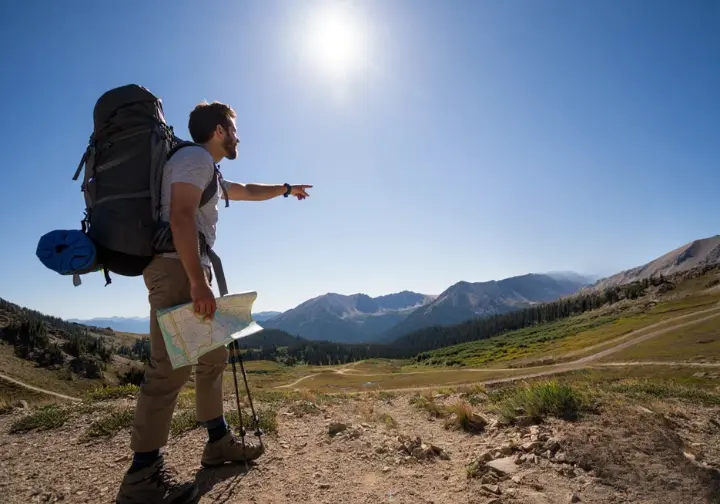
Now we’ll transition from commercial options to empower dedicated hikers with the tools to plan their own independent adventures. This is the ‘choose your own adventure’ part of the guide, directly fulfilling our mission to build your skills.
Planning Your Own Multi-Day Backpacking Trip
The first step in a DIY backpacking trip is Route Selection & Research. Choose a destination that matches your skills and goals from Colorado’s iconic options like the Four Pass Loop or Chicago Basin. This requires thorough research using digital tools like AllTrails and CalTopo for topographic maps and recent trip reports, supplemented with reliable physical maps and guidebooks. This non-negotiable step lays the foundation for a safe trip.
Once a route is chosen, the complex Logistics of Self-Reliance begin. Permitting is often the biggest hurdle for popular areas. Transportation for point-to-point treks must be arranged, and access to trailheads may require high-clearance 4WD vehicles. For longer treks, a resupply strategy involving mail drops to trail towns like Leadville or Buena Vista is essential.
Proper Gear & Food planning is fundamental to safety. A gear list must start with the Ten Essentials and expand to include your primary camping gear: the ‘big three’ (backpack, shelter, sleep system) and a reliable water filter. This is distinct from trips where gear is provided; here, you’ll need all your own camping gear. And of course, learning how to pack a backpack correctly is a critical skill for comfort and efficiency on the trail.
A Closer Look: Colorado’s Premier Backpacking Routes
The Four Pass Loop in the Maroon Bells-Snowmass Wilderness is arguably Colorado’s most famous backpacking trip. This strenuous 27-mile loop crosses four mountain passes over 12,000 feet and involves over 8,000 feet of elevation gain. While the world-class scenery is the draw, the primary challenge is navigating the extremely competitive and restrictive permit system, which requires booking months in advance.
Chicago Basin, deep in the remote Weminuche Wilderness, is a legendary destination for bagging four 14ers (Eolus, North Eolus, Sunlight, and Windom). This stunning hike is a true backcountry trip. A unique aspect of this trip is the access via the historic Durango & Silverton Narrow Gauge Railroad. The key challenges are the area’s remoteness and the intense physical demands of high-altitude peak climbing. You can find more details on these iconic destinations like Maroon Bells-Snowmass Wilderness in our other guides.
The Pawnee-Buchanan Pass Loop in the Indian Peaks Wilderness is a more accessible, yet still very strenuous, 27-mile high-country loop closer to the Front Range. It crosses two major passes on the Continental Divide, offering dramatic scenery and sustained exposure to high altitude and unpredictable weather. This makes it a classic great hike and challenge for experienced Colorado backpackers.
Destination Dossiers for the Colorado Hiker
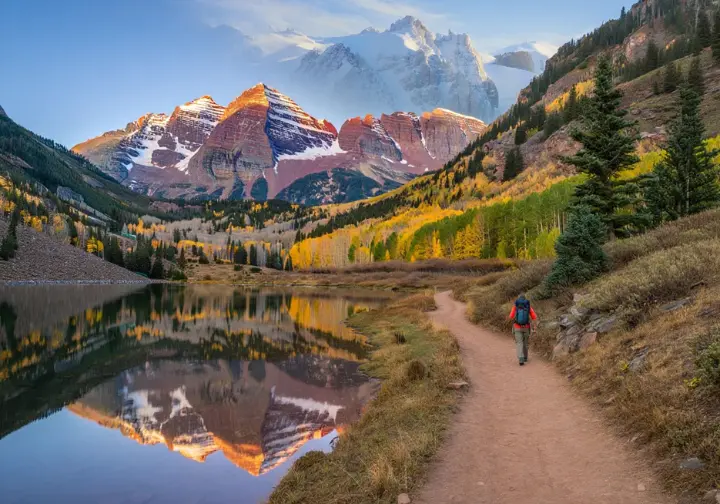
Here, we provide detailed, actionable intelligence on Colorado’s most prominent hiking hubs and top hiking destinations. Each dossier functions as a mini-guidebook, satisfying specific search queries and building topical authority, with a special focus on demystifying complex permit systems.
Rocky Mountain National Park (RMNP): The Crown Jewel
Rocky Mountain National Park is an iconic national park destination with 355 miles of trails, offering a full spectrum of hiking. You can explore the official park statistics for RMNP to appreciate its scale. For beginners, the 2-mile Dream Lake Trail is an easy hike that offers immense scenic reward. There are many day hike options like this one. For a greater challenge, the 4-mile Lily Mountain trail provides stunning panoramic views. There are many signature hikes like the challenging Sky Pond in Rocky Mountain National Park for those seeking a classic RMNP experience.
The park’s popularity has led to a complex reservations system. Access requires up to three separate components: a Park Entrance Pass, a season-specific Timed Entry Permit, and for overnighters, a Wilderness Camping Permit. A campground reservation does not count as a timed entry permit for the following day. We strongly advise you review the official RMNP timed-entry permit system well in advance. This is also a prime destination for Rocky Mountain backpacking, but permits are required.
| Scenario | Park Pass Needed? | Timed Entry Permit Needed? | Wilderness Permit Needed? |
|---|---|---|---|
| Day Hike, Bear Lake Rd, 7am (Summer) | Yes | Yes (“Park Access+”) | No |
| Day Hike, Trail Ridge Rd, 2pm (Summer) | Yes | Yes (“Park Access”) | No |
| Entering Park on foot/bike | Yes | No | No |
| Multi-day Backpacking Trip | Yes | No (Wilderness Permit covers access) | Yes |
| Staying at a Park Campground | Yes | Yes (for vehicle entry on first day) | No |
The Colorado Trail (CT): A Long-Distance Journey
The Colorado Trail (CT) is a premier 486-mile high-altitude trail stretching from Denver to Durango. While some thru-hike the entire length, the most common ways to get the Colorado Trail experience are through section hiking or day hiking. Its accessibility allows for a wide range of experiences. You can find maps and information on all the official starting points for the Colorado Trail on the foundation’s website.
For those new to Colorado backpacking, certain CT segments are more approachable. Segment 1 near Denver offers a gentle introduction, while Segment 6 near Breckenridge provides a true high-alpine experience with easier logistics. This curated advice, often supported by resources from CTF trips and guides, helps beginners make an informed choice beyond raw mileage data. The CT holds its own against other thru-hikes on the North America’s Triple Crown (Appalachian Trail, Pacific Crest Trail, Continental Divide Trail).
A common point of confusion is the trail’s difficulty. Is it beginner-friendly or arduous? Both are true, depending on the context. A short day hike on the CT is very different from a multi-day backpacking trip at high altitude with a full pack. Understanding this distinction is crucial for realistic planning.
The Maroon Bells-Snowmass Wilderness: Regulated Beauty
The Maroon Bells-Snowmass Wilderness is home to some of North America’s most photographed peaks near Aspen, but its immense popularity has made it one of the most highly regulated wilderness areas in the country. Planning a trip here, whether for a day or overnight, requires navigating a complex and strict web of rules and advanced reservations. It’s a prime example of iconic mountain experiences like the Maroon Bells near Aspen.
This table consolidates critical rules that are often fragmented across official sources. You must consult the official regulations for Maroon Bells-Snowmass Wilderness and make your reservations for Maroon Bells overnight permits far in advance.
| Regulation Type | Rule | Why It Matters |
|---|---|---|
| Overnight Permits | Required for all overnight trips in high-use zones. Extremely competitive. | Manages high demand in a fragile ecosystem. |
| Day-Use Access | Reservations required for bus or personal vehicle access during peak season. | Controls traffic and crowding at Maroon Lake. |
| Bear Canisters | Approved, hard-sided bear canisters are mandatory for all overnight stays. | Protects both hikers and the local bear population. |
| Human Waste | All human waste (poop) must be packed out using W.A.G. bags. | Prevents water contamination and preserves the wilderness character. |
| Campfires | Prohibited above 10,800 feet and in many designated zones. | Reduces wildfire risk and protects fragile alpine vegetation. |
| Group Size | Maximum group size is 10 people. | Minimizes social and environmental impact on the trails and campsites. |
The Colorado Hiker’s Essential Knowledge Base
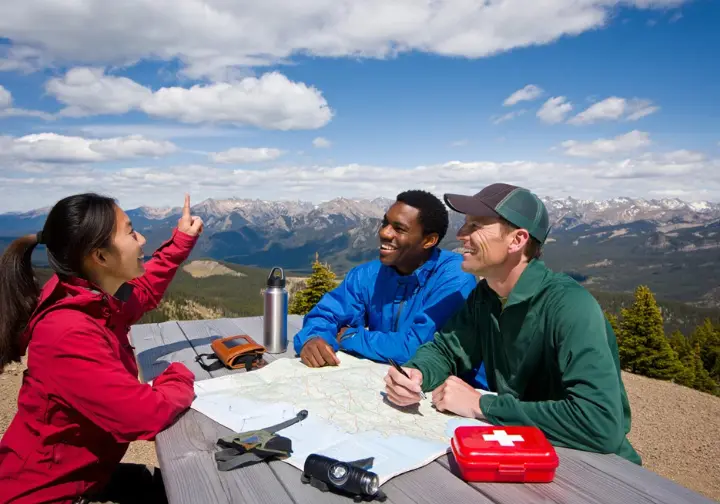
Let’s cover the universal, non-negotiable information required for safe and responsible hiking anywhere in Colorado. Mastering these topics is foundational to any successful trip.
High-Altitude Preparedness and Altitude Sickness
Acute Mountain Sickness (AMS) is the single greatest physiological risk for hikers and climbers in Colorado, caused by ascending too quickly for the body to adapt to lower oxygen levels at high elevation. The golden rules of acclimatization are to ascend slowly, spend a night in Denver (5,280 ft) before moving higher, and follow the “climb high, sleep low” maxim. This is a core part of safety, just as knowing that the Ten Essentials are a time-tested survival philosophy is.
The CDC provides clear, evidence-based guidelines for high-altitude travel and altitude illness. Once sleeping above 10,000 feet, one should not increase sleeping altitude by more than 1,600 feet per day and should incorporate a rest day for every 3,000 feet gained. Proper hydration (3-4 liters per day) is critical, and alcohol should be avoided for the first 48 hours. A detailed guide to high altitude acclimatization can provide more in-depth information.
For moderate to severe symptoms, the only definitive treatment is immediate descent. A drop of just 1,000 to 3,000 feet can bring rapid relief. Prophylactic medication like Acetazolamide (Diamox) can be effective but requires a doctor’s prescription and consultation.
The Leave No Trace (LNT) Ethos in Colorado
The seven Leave No Trace (LNT) principles are the backbone of modern outdoor ethics. They are essential for protecting Colorado’s fragile, high-traffic ecosystems. Plan Ahead and Prepare in Colorado means checking not just weather but also fire bans. Dispose of Waste Properly means packing out all trash, including food scraps, and knowing how to dig a proper cathole 200 feet from water when you camp. Understanding the seven Leave No Trace principles for environmental stewardship is a responsibility for all hikers.
Travel and Camp on Durable Surfaces is especially critical in the alpine tundra, where a single footstep off-trail can create a scar that lasts for centuries. Likewise, the living cryptobiotic soil crusts in desert environments are easily destroyed. Staying on established trails and campsites is a non-negotiable rule for responsible camping. The official LNT organization has a full breakdown of the 7 Leave No Trace principles. Local organizations also adapt these, such as the care for Colorado principles.
Minimize Campfire Impacts is vital due to the high risk of wildfire. Many wilderness areas prohibit fires entirely above a certain elevation. Where permitted, always use an existing fire ring, keep fires small, and ensure they are completely extinguished and cold to the touch before leaving.
Essential Gear, Safety, and Trail Etiquette
The Ten Essentials are a mandatory safety system for any Colorado hike. This includes Navigation (map, compass), Sun Protection, Insulation (extra non-cotton layers), Illumination (headlamp), First-Aid, Fire starter, Repair kit, extra Nutrition, extra Hydration, and an Emergency Shelter. It should be supplemented with proper hiking shoes and optional but helpful gear like trekking poles (also called hiking poles). The the Ten Essentials system is the foundation of any gear list.
Key Colorado-specific safety protocols include mitigating lightning risk by being off all summits and exposed ridges by noon. For wildlife encounters, it’s crucial to know the proper response: make noise for bears, but run and find cover from aggressive moose. Always leave a detailed trip plan with a reliable person, as cell service is non-existent in most mountain areas.
Proper trail etiquette ensures a safe and pleasant experience for everyone. Uphill hikers always have the right-of-way. On multi-use trails, bikers yield to hikers, and everyone yields to equestrians. When passing from behind, a polite “on your left” is standard practice to avoid startling others.
Conclusion: Your Journey to the Colorado High Country
The key to a successful Colorado hiking trip is starting with a clear understanding of your personal constraints and goals—your time, desired scenery, and group skill level—before looking at specific trails. Colorado offers a full spectrum of experiences, from fully supported all-inclusive tours to completely self-reliant backpacking expeditions, with innovative models like slack-packing providing a bridge between the two. Regardless of the trip style you choose, mastering the principles of high-altitude preparedness, practicing Leave No Trace ethics, and always carrying the Ten Essentials are the foundations of safe mountain travel. Use this guide as a launchpad to begin planning your own unforgettable Colorado adventure.
Frequently Asked Questions about Colorado Hiking Trips
What is the absolute best month to hike in Colorado? +
I’m a beginner from sea level. How can I avoid altitude sickness? +
What’s the main difference between getting a permit for Rocky Mountain National Park versus the Maroon Bells? +
Are there any good multi-day backpacking trips in Colorado suitable for a first-timer? +
We are a participant in the Amazon Services LLC Associates Program, an affiliate advertising program designed to provide a means for sites to earn advertising fees by advertising and linking to Amazon.com. As an Amazon Associate I earn from qualifying purchases. We also participate in other affiliate programs. The information provided on this website is provided for entertainment purposes only. We make no representations or warranties of any kind, expressed or implied, about the completeness, accuracy, adequacy, legality, usefulness, reliability, suitability, or availability of the information, or about anything else. Any reliance you place on the information is therefore strictly at your own risk. Additional terms are found in the terms of service.



